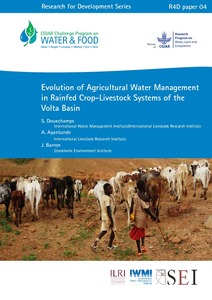Resource information
This study of the evolution of AWM in the Volta Basin yielded key recommendations for research-for-development interventions and new concepts for research on water management. When promoting AWM strategies, projects should carefully study the available information on factors triggering adoption,
and play on these to ensure sustainable uptake of the technology. Local capacities and agendas should be better accounted for when promoting AWM strategies or low-cost irrigation technologies. Participatory
management of the water infrastructure should be carefully planned through integration of maintenance
costs in project budget, capacity building of actors towards assumption of more responsibility, and ways
to deal with turnovers within management committees. Farmers’ capacity building is definitely a key
asset for enlightened risk management and constant adaptation to new variable conditions.
Future research and development projects should concentrate on how to leverage the factors limiting
adoption and enhancing system productivity while maintaining healthy ecosystem services. There is a need
for a system perspective, to improve water-crop-livestock interactions, to develop off-season cultivation
options and market access, and to balance distribution of gender benefits.
There is a need for a multi-scale,
landscape perspective, to understand ecological landscape processes and trade-offs between ecosystem
services derived from and affected by AWM strategies adoption across different scales. There is a need for
an institutional perspective, to facilitate management of AWM structures and to raise awareness. Finally, there is a need for a long-term perspective, to foresee the best strategies for adaptation to climate change and manage risk in the variable environment of the Volta Basin.


